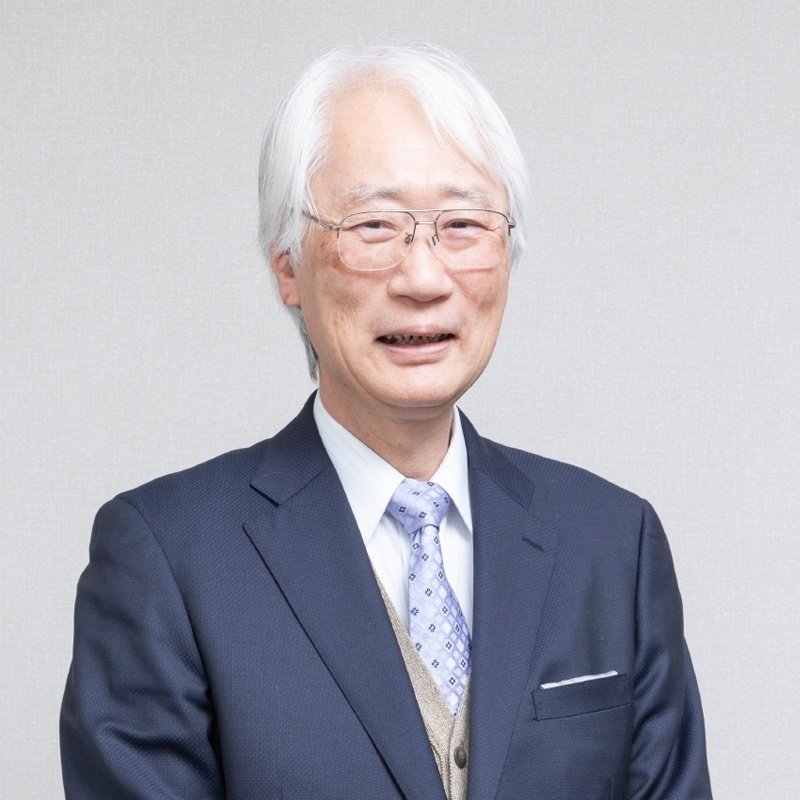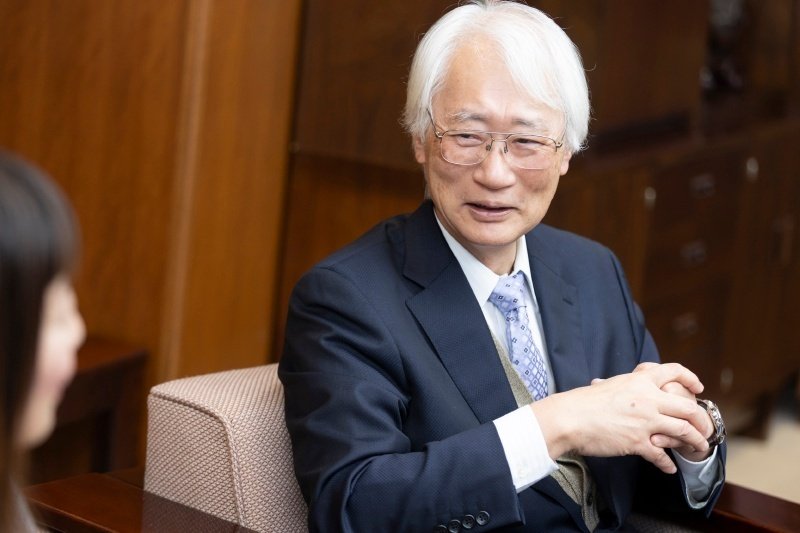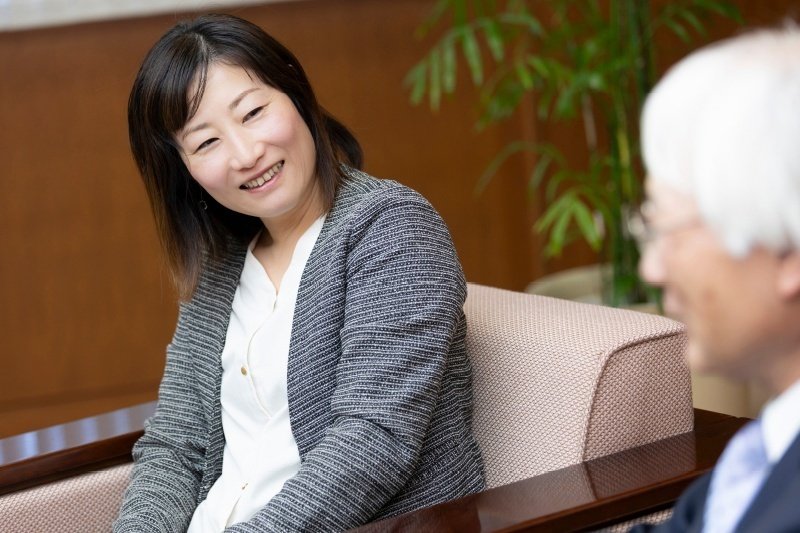
Combining eastern and western knowledge to change the states of medicine and society in the future: SAITO SHIGERU×MACHII ERI
"When you examine various diseases, you often see that disease onset occurs suddenly at a particular point in time rather than as a gradual decline in health, slowly giving way to disease. Why is this?”
This question was the start of research in the unknown field of pre-disease.
Saito Shigeru, a performer in the Moonshot project “Comprehensive Mathematical Understanding of the Complex Control System between Organs and Challenges for Ultra-Early Precision Medicine,” hopes to create a new method of medical treatment in the near future that will lead to a healthier and brighter society. His desire is shared by Machii Eri, representative director of AfriMedico, an NPO carrying out medical activities in Africa, such as the distribution of medicines on a pay-what-you-use basis. Here, they discuss how medical treatment will change because of research into pre-disease and its expected impacts on society.


A chance meeting with mathematical science
Machii: Toyama is known for its traditional Chinese medicines and for the old system of delivering medicines and charging only for what was used. I visited the Toyama prefectural office when I was a graduate student studying for my master’s in business administration (MBA) when I learned about the history and operation of this system. That led to my current job in Africa.
Saito: You are a pharmacist, aren’t you? People who deliver medicines on a pay-what-you-use basis, need to be knowledgeable about the medicines they deliver. You listened to the symptoms and recommended them a medicine that will help.
Machii: We are working on activities to spread self-medication, which is the idea of people taking care of their own health, so that local people will try to prevent disease through the pay-what-you-use system of medicine. I see the system as form of triage, one of the steps to be taken before actually going to a hospital.

The University of Toyama is home to the Institute of Natural Medicine. I would like to know if your research area, pre-disease, derives from traditional Chinese medicine. Since pre-disease means “not yet in a disease state,” I would not have thought of that as a disease, per se.
Saito: We once surveyed the general public to ask them whether they see pre-disease as a form of disease. About half of the respondents said it is not a disease, but a healthy state. The pre-disease that our research group is working on is what we consider a pathological stage.
I first learned about pre-disease from the Huangdi Neijing (The Yellow Emperor’s Classic of Medicine), the world’s oldest known medical treatise, which was written in China 2,300 years ago. Talking about pre-disease, it says that “the doctor who is able to cure pre-disease is a superior doctor to all. The doctor who cures a disease after it has appeared is of the lowest rank.”
I thought this was amazing. As clinicians, we see many patients who suddenly become unwell and develop a disease at some definite point in time, rather than experiencing a gradual decline in health that slowly develops into a disease. So, I then wondered when the disease actually began in such patients. In other words, I sensed the existence of pre-disease.
Seen from the perspective of ancient Chinese medicine, modern medicine is an inferior form of (or approach to) medical care.
Machii: I see. That’s very surprising.

Saito: So, if we look at medicine in the not-too-distant future, we will aim to catch the pre-disease state and treat it as soon as possible, so that it does not become a disease. Alternatively, we will be able to delay the onset of disease for as long as we can. We launched the pre-disease research project with these aims in mind.
The first thing we wished to clarify was the stage of pre-disease. Our thinking was that it would surely be easier to return the body to its normal state by addressing pre-disease in some way or other rather than by waiting to treat a disease.
The impetus for tackling this issue came from mathematical science research into the dynamical network biomarker (DNB) theory developed by the team of Aihara Kazuyuki, University Professor / Professor Emeritus, The University of Tokyo, who is currently the project manager of a Moonshot Goal 2 R&D project. They proved theoretically that, before disease, there is a period in which symptoms and substances within the body fluctuate considerably. After that, the physical state declines rapidly, and the body enters a disease state (Fig. 1). Professor Aihara’s team regarded that this period of significant fluctuation must be pre-disease, so they proposed a joint research project with the University of Toyama to prove this theory in animal studies. As a result, the Research Center for Pre-Disease Science was launched in 2020 as a university-wide attempt to clarify pre-disease. It includes 48 researchers from seven departments of the University of Toyama.

Machii: So, this led to your Moonshot research project?
Saito: Until now, doctors and biologists have always judged clinical and biological data based on the mean. If there is a difference between the mean value of something in the healthy state and the mean value in the disease state, then this index becomes the standard for disease diagnosis. In a state of significant fluctuation, such as the pre-disease state, there is tremendous variability (i.e., errors) in the data, which become statistically meaningless, so they have always been discarded. In DNB theory, however, large fluctuations like this are seen as extremely significant events. This significance was a big eye-opener for us.
Pre-disease starts with complex control systems among organs
Machii: How do you go about identifying these fluctuations that show pre-disease?

Saito: Let me illustrate this using metabolic syndrome. We tracked changes in gene expression in the adipose tissues of a mouse model featuring spontaneously developed metabolic syndrome at around 24 weeks of age. We found 147 genes (factors that are markers) that fluctuate greatly from around 19 weeks before disease onset. We carried out a detailed investigation with the help of mathematicians and found that two of these genes are involved in the lipid metabolization.

Machii: So, you were able to define pre-disease in scientific terms?
Saito: Also, in research looking at obesity using mice, we have analyzed not only adipose tissues, but also cells from many organs and tissues, such as muscles, the brain, heart, immune system, liver, and digestive tract. An interesting result has emerged very recently—while major changes occur in the adipose tissues early on, at around 4 weeks of age, changes occur later in the muscles, brain, and heart as fluctuations at about 6 weeks of age.
Machii: Is this the complex control system among organs that features in the name of the Moonshot project?
Saito: Yes, that’s right. The organs in the body form a network, and various organs are related to pre-disease. If we could identify the organs in which changes first appear, we would be able to develop medicines or other therapies to return those organs to their normal state. First, I would like to clarify what sorts of tests are best for identifying pre-disease organs.
Machii: Large numbers of people in Africa have malaria, which develops when a person is bitten by a mosquito, but is there a pre-disease stage?
Saito: The diseases with a pre-disease stage are mainly chronic ones in which the disease state changes gradually.
Machii: Does that mean diseases like cancer or diabetes?

Saito: Yes. Metabolic syndrome, psychiatric diseases, and dementia would also be possibilities.
Machii: A huge number of tests will be needed to elucidate pre-disease. Apart from metabolic syndrome and diabetes, are there any other cases that have been analyzed?
Saito: In collaboration with engineering researchers, we have used a special type of microscope, called a Raman microscope, to identify the pre-disease state of leukemia. This groundbreaking research gave us information straight from living cells about their precancerous state.

Machii: Have you reached the point where you can estimate how many months or years until the disease develops if nothing is done at the pre-disease stage?
Saito: We will certainly get there; however, the tests we are carrying out at present are animal studies, so we need to build a system of noninvasive testing that can use human clinical data.
Machii: It would be easy to conduct tests if they were carried out using urine, saliva, or blood.
The pre-disease approach and how it differs from preventative medicine
Machii: When you understand pre-disease in greater detail, will you be able to approach treatment from the pre-disease stage?
Saito: I believe natural medicines may be effective at the pre-disease stage. Western drugs, such as analgesics for pain or antipyretics for fever, are symptomatic treatments. No symptoms have developed at the pre-disease stage, so there would be no need to use these drugs. I think traditional Chinese medicines are better suited for treating pre-disease, as they maintain the body’s balance through the combined actions of various ingredients.
In fact, experiments using mice with spontaneously occurring metabolic syndrome have demonstrated that fluctuations can be eliminated, thereby suppressing the onset of diabetes and high blood pressure, through the use of traditional Chinese medicine. At the same time, giving drugs for hyperlipidemia or antihypertensive drugs at the pre-disease stage would have no effect.
Herbal medicines are still commonly used in China and elsewhere in Asia as traditional medicine, and they are used in Africa, too, I believe.
Machii: I have seen close up how the Masai people use herbal medicines to prepare a range of different medications. They even have a love drug!

Saito: I would like to use natural medicines from both Asia and Africa, and I am currently working on plans to extract and screen ingredients in the regions where they are used.
Machii: That’s a very interesting plan. You would be very welcome to make use of our network in Africa. Do you have any approaches besides medicines?
Saito: Exercise and diet are also important. We are still told to walk 8,000 steps a day, or that too much fat in one’s diet is bad, and I’m sure these would also affect pre-disease.
Machii: If you don’t actually feel like anything is wrong, it is difficult to take action, such as taking medication or being careful about diet and exercise.
Saito: This is because it is a preventative medicine approach, with no clear-cut sign of pre-disease.
Machii: Is there a difference between preventative medicine and the pre-disease approach?
Saito: Preventative medicine is carried out with all the people who are at risk of a particular disease. Let’s say that a healthy person (one not considered at risk) has a 5% chance of contracting a particular disease. A person with twice the likelihood—in other words, a 10% chance—of developing the disease might be judged as at risk for the disease and would, therefore, be a candidate for preventative treatment. For example, compared with healthy people, those with high cholesterol are at a greater risk of suffering cerebrovascular disease, or cardiovascular disease. Therefore, to prevent these, people who are at risk take drugs to reduce their cholesterol levels. However, if only 10% of the people actually develop the disease, then the remaining 90% would not have developed the disease anyway and therefore didn’t need to take the drug.
Pre-disease treatment, by contrast, targets those who have not developed symptoms but are showing fluctuations and will soon go on to develop the disease. In other words, the 90% who won’t develop the disease can be excluded from the treatment.

Machii: So, the treatment of pre-disease is a radical therapy. It also leads to self-medication, in which people manage their own health themselves.
Saito: Absolutely. If you have pre-disease tests at a health checkup and are told that you are in the second of five pre-disease stages, say, or that you are already in the fourth stage, your awareness will change quite substantially.
Machii: When we deliver drugs to people in Africa on a pay-what-you-use basis, we try to educate them in prevention by explaining what they could have done to avoid using the drugs. However, it can be very difficult to change people’s awareness. I’m sure that if we had a health checkup system where people got points for being healthy, far more people would be health-conscious in their lifestyles!

Fluctuations in pre-disease will shake up medicine and society
Machii: Under the present system of drug development, things like animal studies and safety assessments are strictly prescribed in different phases. Will a new system be needed for drug discovery aimed at pre-disease conditions?
Saito: This is where we researchers will need to show that pre-disease is a disease. At the same time, the Japanese Ministry of Health, Labour and Welfare, which is the authority responsible for medicines will need to accept this view.
From the point of view of medical economics, treating diseases at the pre-disease stage will lead to a massive reduction in medical costs. We will need to demonstrate the savings that can be made in social security costs if there is a decrease in the number of people who develop disease.
Machii: It really is a case of prevention being better than the cure. I think being able to show proper economic benefits would have an incredible impact.
If the radical therapy of pre-disease becomes widespread, I imagine it will change our way of life.
Saito: Ideally, what I want to do is to extend the healthy life expectancy. If we can prevent the onset of many diseases in advance, it will enable people to live in good health to old age. The period during which people work and earn an income will be extended, while the period during which people need nursing care will become shorter. I want people nearing the end of their lifetime to be able to look back with satisfaction that they have led a good life.
I think Japanese society will also change. I’ve heard that many young people today choose not to have children because they are worried about their old age. Society would surely become a lot brighter if more older people were able to live independently without having to rely on their children.
Machii: Research into pre-disease began in Japan, so in that sense, Japan is an advanced country in the field of pre-disease.

Saito: Yes, it is. We want to spread the concept of pre-disease across the world.
Machii: In Africa, where I work, there are a great many young people, so the population structure is very different from that of Japan. In the future, the population will grow so that the number of older people will increase, but we are also seeing an increase in obesity and lifestyle diseases due to the Westernization of people’s diets.
While many young people are careful about what they eat, it is not uncommon for middle-aged people to see being overweight as a sign of wealth, and there has been a sharp increase in the number of patients in this age group with diabetes or dyslipidemia. This means that it may, perhaps, be necessary to tailor the approach to different age groups when bringing up the concept of pre-disease.
Saito: There is tremendous power in Africa. Is it because there are so many children?
Machii: I am amazed by the ability for action. For example, internet banking on smartphones spread rapidly, even before landlines had become commonplace. Very often, new technologies or services develop and spread by leapfrogging over existing ones. So, there is certainly the possibility that the concept of pre-disease will spread quickly.
If the concept of pre-disease rapidly permeates Africa, the whole social system is likely to change all at once. This is not limited to Africa, however—the fluctuations of pre-disease will cause fluctuations across the whole world. This is absolutely amazing. I can’t wait to see the future research for this project.
Written by Fukushima Sakiko
Photos by Mori Takahiro
Related information
■Moonshot Research and Development Program
■Moonshot Goal2
Realization of ultra-early disease prediction and intervention by 2050.
■Goal 2 R&D Projects
Comprehensive Mathematical Understanding of the Complex Control System between Organs and Challenge for Ultra-Early Precision Medicine
(Project Manager: Aihara Kazuyuki)
■ University of Toyama Research Center for Pre-Disease Science
・Message from Director Saito
・What is moonshot research?


